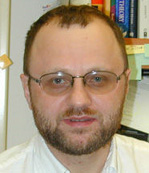Dr. Andrey Rzhetsky
The MIT Technology Review article Mapping Complex Diseases: A computer model of epidemiological data from 1.5 million people illuminates the genetic origins of many common diseases said
“Certain diseases caused by single genetic mutations are correlated with other conditions in well-known ways, says Andrey Rzhetsky, the leader of the mapping project, who is now a professor of genetic medicine at the University of Chicago. For example, the same mutation in the gene for hemoglobin, the protein that carries oxygen in the blood, causes sickle-cell anemia but protects against malaria. Unlike sickle-cell anemia, however, most diseases aren’t caused by a single mutation. The genetic factors underlying most common diseases, such as diabetes, addiction, and heart disease, are complex and poorly understood. But Rzhetsky found connections between genetically complex diseases, too.Using health records from the Columbia University Medical Center, Rzhetsky’s group examined the likelihood that a patient with one genetically complex disease — for example, diabetes — also had one of the 160 other diseases under study, such as an autoimmune disorder. The researchers concluded that certain groups of genes can predispose a person to multiple diseases, while others can predispose a person to one disease while protecting against another.”
Andrey Rzhetsky, Ph.D. is Professor of Medicine, Section of Genetic Medicine, The University of Chicago. His research is focused on computational analysis of signal-transduction pathways.
Andrey authored the software STATIO: Program package for testing stationarity of base composition and Models: Program package for testing a data set for compatibility with a model of nucleotide substitution, and coauthored the software METREE: Program package for inferring and testing minimum evolution trees, rRNA: Program package for rRNA analysis, and GeneWays: a system for automatically extracting, analyzing, visualizing and integrating molecular pathway data from the research literature. This system focuses on interactions between molecular substances and actions, providing a graphical consensus view on the collected information.
He edited the book Mathematical Hierarchies and Biology: Dimacs Workshop, November 13–15, 1996 (Dimacs Series in Discrete Mathematics and Theoretical Computer Science), and coauthored the publications Probabilistic inference of molecular networks from noisy data sources, Listening to Viral Tongues: Comparing Viral Trees Using a Stochastic Context-Free Grammar, GeneWays: a system for extracting, analyzing, visualizing, and integrating molecular pathway data, Learning to predict protein-protein interactions from protein sequences, Automatically identifying gene/protein terms in MEDLINE abstracts, Birth and death of protein domains: A simple model of evolution explains power law behavior, Two biomedical sublanguages: a description based on the theories of Zellig Harris, and The human ATP-Binding cassette (ABC) transporter superfamily. Read his full list of publications!
Andrey earned his MS in Mathematical Biology from the Novosibirsk State University, Russia in 1985 and his Ph.D. in Genetics from the Institute of Cytology and Genetics in 1990. He did his postdoctoral work with Professor Masatoshi Nei at Pennsylvania State University, developing models of nucleotide substitution and algorithms for phylogenetic tree inference.
